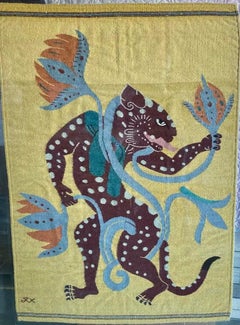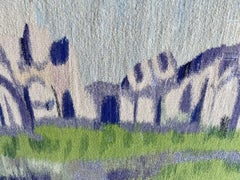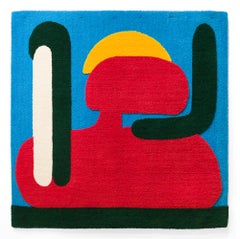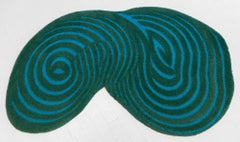Heart of Gold Gallery More Art
to
3
Overall Width
to
Overall Height
to
3
2
1
3
3
3
Dancing Jaguar
Located in Mount Pleasant, SC
A vintage decorative rug from the Zapotec Indian tribe in Oaxaca, Mexico, 39.5" x 57"
Native American hand woven rug.
The Zapotec rugs and weavings ava...
Category
19th Century Other Art Style More Art
Materials
Wool
$6,875
Wind of God and Fire
Located in Mount Pleasant, SC
Hand woven Native American Zapotec rug.
Original rug in beautiful condition.
Category
19th Century Other Art Style More Art
Materials
Wool
Landscape
Located in Mount Pleasant, SC
Hand Woven Native American Zapotec rug.
Original rug in beautiful condition.
Category
19th Century Other Art Style More Art
Materials
Wool
$6,875
Related Items
"DALL·E 2023-05-29 21.08.13" Whimsical Abstract Wool Rug/Tapestry
Located in Philadelphia, PA
This piece titled "DALL·E 2023-05-29 21.08.13" is an original artwork by Tuft the World and is made tufted 100% New Zealand wool, and part of the inaugural launch of TTW Editions. Th...
Category
21st Century and Contemporary Contemporary Abstract Sculptures
Materials
Wool
"DALL·E 2023-04-23 11.28.28" Unique shape tufted rug with abstract pattern
Located in Philadelphia, PA
This piece titled "DALL·E 2023-04-23 11.28.28" is a crafted original piece by Tuft the World as part of the inaugural collection of TTW Editions. This piece measures 43"h x 66"w and ...
Category
21st Century and Contemporary Contemporary Abstract Sculptures
Materials
Wool
Hand-Needlepoint Nantucket Breeze Coastal Scene Finished Panel
Located in Bristol, CT
Panel Sz: 11 1/4"H x 19 3/4"W
Frame Sz: 14 1/4"H x 22 3/4"W
1989 Dimensions
Charles Wysocki's Nantucket Breeze
Category
20th Century More Art
Materials
Wool
"MJ-af66128ff0c0" Green Red and Yellow Abstract Tufted Wool Tapestry/Rug
Located in Philadelphia, PA
This piece titled "MJ-af66128ff0c0" is an original artwork by Tuft the World and is made tufted 100% New Zealand wool, and part of the inaugural launch of TTW Editions. The artists t...
Category
21st Century and Contemporary Contemporary Abstract Sculptures
Materials
Wool
Classic LOVE
By Robert Indiana
Located in Jerusalem, IL
This piece is from the LOVE rugs series by Robert Indiana, issued by Galerie f in 2007. This rug is an editioned, hand-carded carpet by Robert Indiana. Th...
Category
Early 2000s Pop Art Mixed Media
Materials
Fabric, Wool, Cotton Canvas
Pastel Cluster of c1960s Needlepoint Bermuda Houses
Located in Bristol, CT
Colourful patch-panel c1960s pastel needlepoint houses/ rooftops
Panel Sz: 22"H x 27 1/8"W
Frame Sz: 24"H x 29 1/4"W
w/ fuchsia mat & gilt bamboo frame
Signed by the needlepointis...
Category
1960s Other Art Style More Art
Materials
Wool
Hand-Needlepoint Floral Bouquet
Located in Bristol, CT
Colourful needlepoint floral bouquet
in a lovely gilt frame w/ French blue inlay
c1960s
Art Sz: 25"H x 19"W
Frame Sz: 29"H x 22 3/4"W
Category
1960s More Art
Materials
Wool
Petit-Needlepoint Radnor Fox-Hunt Panel
Located in Bristol, CT
Petit-needlepoint foxhunter w/ fox-head top centre
Ex- equestrian estate in Chester Co, PA
Sz: 14”H x 16”W
Perfect library/ den/ club room accent piece
either under tabletop glass...
Category
20th Century More Art
Materials
Wool
Cherry Pom-Pom
By Gina Phillips
Located in New Orleans, LA
JONATHAN FERRARA GALLERY is proud to announce, Shape-Memory, a solo exhibition of new textile and sculptural artworks by New Orleans-based artist Gina Phillips. Initially born from h...
Category
21st Century and Contemporary Contemporary More Art
Materials
Wool
Victorian 19th Century "King Charles Spaniel" Needlepoint Slipper Last Canvas
Located in Bristol, CT
Original 19th Century Victorian King Charles Spaniel with garland adornment needlepoint slipper hand-coloured screen
Wool
Canvas Sz: 14 1/2"H" x 22 1/4"W
Frame Sz: 19 1/2"H x 27"W...
Category
1890s Other Art Style More Art
Materials
Wool
$1,400
H 14.5 in W 22.25 in D 1 in
Night Pom-Pom
By Gina Phillips
Located in New Orleans, LA
JONATHAN FERRARA GALLERY is proud to announce, Shape-Memory, a solo exhibition of new textile and sculptural artworks by New Orleans-based artist Gina Phillips. Initially born from h...
Category
21st Century and Contemporary Contemporary More Art
Materials
Wool
Hand-Needlepoint Backgammon Board
Located in Bristol, CT
Board Sz: 15" x 14 5/8"
w/ plexiglass cover
Frame Sz: 15 5/8" x 16 1/8" x 1 1/2"D
w/ monogram letter: A
Category
1970s More Art
Materials
Wool




